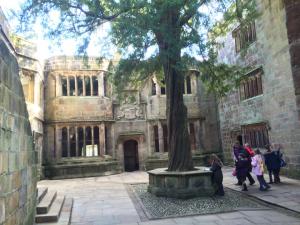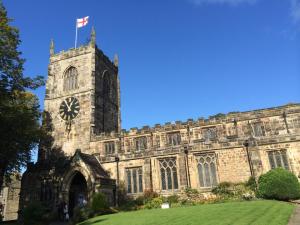I am passionate about history and travel! As soon as I got my passport, I was determined to go out and see the world with my own eyes, but more importantly, to encounter places associated with Richard III. In his brief 32 years, he assembled what has been called by Professor Rosemary Horrox of Cambridge “the largest noble affinity of its day” — meaning, he owned a vast number of castles and estates that we can still visit in the UK.
For me, the most interesting period of Richard’s life as a man began in 1471 when he was only 17 years old and still living in the shadow of his older brothers Edward IV and George, Duke of Clarence. That was the year Richard returned from exile in Burgundy, led his first troops in combat at the Battles of Barnet and Tewkesbury, and received from Edward IV a grant of castles, manors and offices that would form the backbone of his great affinity in the North of England. I had been invited to speak at the 2015 Richard III Foundation’s conference at Market Bosworth, so my husband and I decided to plan our annual holiday around my talk and to visit Ricardian sites from the 1470s that sometimes get overlooked in favor of the more famous ones like Middleham Castle, Fotheringhay, and Bosworth Battlefield.
Upon arriving at Manchester International Airport, we loaded our bags into our rental car and drove only 45 minutes to the strikingly beautiful Forest of Bowland in the “Red Rose” County of Lancashire. In July, 1471, Edward IV granted Richard the Mastership of the Forest of Bowland in the royal duchy lands. It was one of the few Lancashire duchy offices in which Richard was active – in other respects, he deferred to the Stanleys who jealously guarded their familial entitlement to those offices, so much so that Edward IV had to twice intervene and order Lord Stanley to stop meddling in the offices he’d given to Richard.
The Forest of Bowland is the perfect place to decompress after a long trans-Atlantic crossing and to adjust to a new time zone. It’s all rolling green hills dotted with countless sheep, ancient towns and churches, mossy dry-stone walls, and a network of bubbling brooks that swell over their banks during heavy rains. There, we stayed at a very small B&B in Newton-in-Bowland whose friendly owners, outspoken Yorkshire folk (the eastern side of Lancashire is more “White Rose” than “Red Rose” country), were surprised to be receiving guests from America. We were delighted by pleasant views from our bedroom window.
The owners of the B&B directed us to several walking routes in the area, including one on Pendle Hill, famous for its 17th century witches and the place where George Fox, in 1652, had a vision which inspired him to establish the Quaker movement. Not to be deterred by our jetlag, my husband and I succeeded in climbing the very steep 5-mile route up this “hill” (only 90 feet short of being a mountain!) and were treated to stunning vistas of North Yorkshire and the Pennines. At the end of the day, we rewarded ourselves with a hearty pub meal at Parker’s Arms, where we had the best venison burger ever tasted and a pie filled with “salt marsh lamb” and cockles.
Salt marsh lamb, by the way, is a local delicacy and is made from lambs who graze on coastal vegetation which lends a unique flavor to their meat. We’d never encountered it before and it was absolutely delicious with the cockles. Of course, this only made us more excited to try a wide variety of savory pies throughout our trip, and I suppose I could make an argument that sampling them lent another historical dimension since meat pies were greatly consumed during the 15th century. Don’t believe me? OK, I admit we love English pub food. But, anyway, back to history and our trip . . .
The next day we relocated our lodgings to the Masham-Ripon area in North Yorkshire, and this served as our “home base” for the next several days. Ripon is a bustling cathedral town, famous for its racetrack and the “Ripon Hornblower”. It’s also well-situated for making day trips to a plethora of Ricardian sites, including Middleham, Barnard Castle, Sheriff Hutton, Jervaulx Abbey, Fountains Abbey, Coverham Abbey, and Skipton Castle. It was to the latter, Skipton, that we first journeyed.
Skipton Castle touts itself as being “one of the best-preserved and most complete medieval castles in England” according to its pamphlet.
The original motte and bailey wooden castle was erected in 1090, and later replaced by a stone structure in the 12th century. Many elements of the 12th century castle and its chapel are still evident. Edward II gave the castle to the Welsh Marcher lord Robert Clifford in 1310, who initiated additional improvements, and it remained in the Clifford family possession until 1461, when the 9th Lord Clifford was attainted following Towton. Richard obtained possession of Skipton in 1475 when he acquired it from Lord Stanley in exchange for his Welsh castle in Chirk. It remained in Richard’s possession until his death in 1485, and as one can see from the photograph, a large Tudor-period manor house was added by the Clifford family when they regained possession after Bosworth. The combination of medieval and Tudor-style architecture is charming and there is a lovely courtyard.
Skipton was one of the last Royalist holdouts in the North during the English Civil War and surrendered to Cromwell’s army after sustaining a long siege. Fortunately, the attempt to “sleight” the castle didn’t work completely and, while the castle lost its original roofs, the Parliamentarians later permitted Lady Anne Clifford to replace them – with the caveat that they were not strong enough to bear firing cannon. Lady Anne is credited with planting a yew tree in 1659, which still graces the courtyard.
Skipton is also a busy market town, and our visit coincided with their Monday market day. It was enjoyable seeing the local crafts, household goods and foodstuffs being sold on the High Street, many of which had a distinctive Yorkshire flair. We were also surprised to see that Andrew Cargenie, someone from our home state of Pennsylvania, provided the funds for Skipton’s Public Library!
The desirability of possessing Skipton must have been very high for Richard. It had not only a fine castle with a garden, park, game reserves, private chases over the Pennine uplands and dales, but also a flourishing agriculture, commercial growth in the town, patronage of Bolton Priory, and extensive estates and honorial jurisdiction. It also added to what Professor Horrox has called the “trans-Pennines” base of his nascent affinity.
Richard acted as patron of the local parish church of the Holy Trinity, granting it Ł20 in 1483 for the construction of its oak roof, the timbers of which are still in place today along with their original 15th century roof bosses. The church became a mausoleum for the Clifford family, following the dissolution of Bolton Priory in the 16th century.
For additional reading about Skipton Castle, see Richard T. Spence’s “Skipton Castle and its Builders” (2002) and “The Shepherd Lord of Skipton Castle: Henry Clifford, 10th Lord Clifford 1454-1523” (1994). For additional reading about Richard’s experience as Duke of Gloucester, and his affinity in the North, see Rosemary Horrox’s “Richard III: A study of service” (1989).
Some more photos of our time in Newton-in-Bowland, driving enroute to Skipton via Pateley Bridge, and at Skipton.






